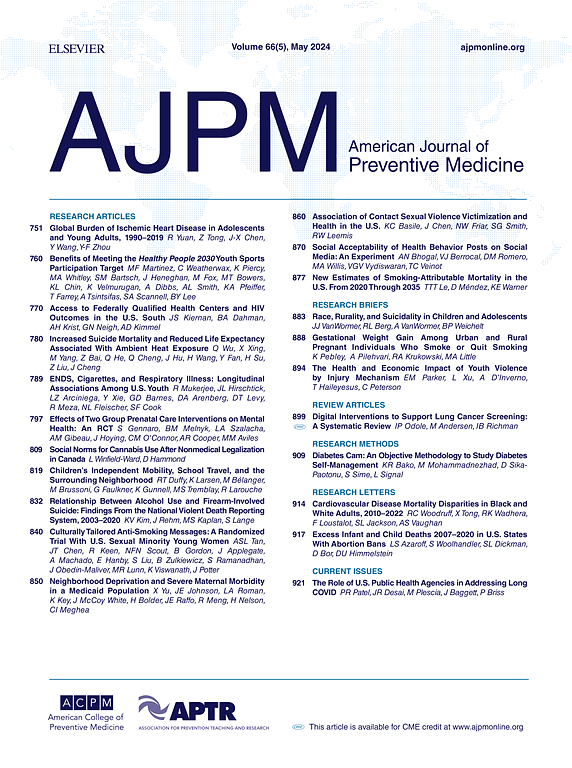Hypertensive Blood Pressure in Adolescent Females With Polycystic Ovary Syndrome
IF 4.3
2区 医学
Q1 MEDICINE, GENERAL & INTERNAL
引用次数: 0
Abstract
Introduction
Polycystic ovary syndrome is associated with hypertension in women, but few population studies have examined findings among adolescents. This retrospective study examines PCOS and hypertensive blood pressure in a large adolescent population receiving routine healthcare.
Methods
Among females aged 13–17 years who had a well-child visit with systolic/diastolic blood pressure measured in a Northern California healthcare system (2013–2019), the outcome of hypertensive blood pressure (≥130/80 mmHg) was examined. Polycystic ovary syndrome was based on clinical diagnosis (ICD-9/10 256.4/E28.2) within 1 year of the visit. Overweight and obesity were defined by BMI 85th to <95th percentile and ≥95th percentile, respectively; 1.7% with underweight (<5th percentile) were excluded. Multivariable logistic regression was used to examine the association of polycystic ovary syndrome and hypertensive blood pressure, adjusting for age, race/ethnicity, BMI category, and estimated neighborhood deprivation index. Analyses were conducted in 2023–2024.
Results
The cohort included 224,418 females (mean age 14.9±1.4 years; 34.3% non-Hispanic White, 30.1% Hispanic, 19.5% Asian/Pacific Islander, and 9.7% Black). Overall, 18.7% had overweight and 15.8% had obesity. The prevalence of hypertensive blood pressure was 7.2%, much higher for those with polycystic ovary syndrome (18.2%) versus no polycystic ovary syndrome (7.1%, p<0.001). In adjusted analyses, polycystic ovary syndrome was associated with 1.25-fold greater odds of hypertensive blood pressure (95% CI=1.10, 1.42). Similar findings were seen among the subset with obesity (OR=1.23 [95% CI=1.06, 1.42]).
Conclusions
Nearly 1 in 5 adolescents with polycystic ovary syndrome had hypertensive blood pressure. Polycystic ovary syndrome was associated with 25% increased adjusted odds of hypertensive blood pressure, emphasizing the importance of blood pressure surveillance in this population with higher cardiometabolic risk.
多囊卵巢综合征青少年女性的高血压:青少年多囊卵巢综合症与高血压。
导言:多囊卵巢综合征(PCOS)与女性高血压有关,但很少有人群研究对青少年进行调查。这项回顾性研究调查了接受常规医疗保健服务的大量青少年群体中多囊卵巢综合征与高血压(BP)的关系:方法:在北加州医疗保健系统(2013-2019 年)中,13-17 岁的女性在接受儿童健康检查并测量收缩压/舒张压后,对高血压(≥130/80 mmHg)的结果进行了研究。多囊卵巢综合征基于就诊一年内的临床诊断(ICD-9/10 256.4/E28.2)。超重和肥胖的定义分别为体重指数第85百分位至第th百分位和≥第95百分位;1.7%体重不足(第th百分位)者被排除在外。多变量逻辑回归用于检验多囊卵巢综合症与高血压之间的关系,并对年龄、种族/人种、体重指数类别和估计的邻里贫困指数进行了调整。分析于 2023-2024 年进行:队列包括 224 418 名女性(平均年龄为 14.9±1.4 岁;34.3% 为非西班牙裔白人,30.1% 为西班牙裔,19.5% 为亚太裔,9.7% 为黑人)。总体而言,18.7%的人超重,15.8%的人肥胖。高血压患病率为 7.2%,患有多囊卵巢综合症的青少年(18.2%)远高于未患有多囊卵巢综合症的青少年(7.1%):近五分之一患有多囊卵巢综合症的青少年患有高血压。多囊卵巢综合症导致高血压的调整几率增加了 25%,这强调了对这一具有较高心脏代谢风险的人群进行血压监测的重要性。
本文章由计算机程序翻译,如有差异,请以英文原文为准。
求助全文
约1分钟内获得全文
求助全文
来源期刊

American Journal of Preventive Medicine
医学-公共卫生、环境卫生与职业卫生
CiteScore
8.60
自引率
1.80%
发文量
395
审稿时长
32 days
期刊介绍:
The American Journal of Preventive Medicine is the official journal of the American College of Preventive Medicine and the Association for Prevention Teaching and Research. It publishes articles in the areas of prevention research, teaching, practice and policy. Original research is published on interventions aimed at the prevention of chronic and acute disease and the promotion of individual and community health.
Of particular emphasis are papers that address the primary and secondary prevention of important clinical, behavioral and public health issues such as injury and violence, infectious disease, women''s health, smoking, sedentary behaviors and physical activity, nutrition, diabetes, obesity, and substance use disorders. Papers also address educational initiatives aimed at improving the ability of health professionals to provide effective clinical prevention and public health services. Papers on health services research pertinent to prevention and public health are also published. The journal also publishes official policy statements from the two co-sponsoring organizations, review articles, media reviews, and editorials. Finally, the journal periodically publishes supplements and special theme issues devoted to areas of current interest to the prevention community.
 求助内容:
求助内容: 应助结果提醒方式:
应助结果提醒方式:


